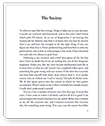Essay Instructions: Week Four - posted by Danna Plewe (ENG122_DL01_2002SP1)
- --"A&P" 606-610
John Updike is one of the rare writers who is able to take the small moments in life and demonstrate how they represent something more. In this work, he takes us into the A&P, a small supermarket, on a hot summer afternoon. Nothing that happens in the store is overly exciting. Nothing that happens is unique. Nothing is necessarily special. It is precisely because it is so ordinary that it means so much.
Now, I know many of you men are sitting back right now saying ?I wouldn?t/haven?t quit my job for any woman.? And you?re probably in the majority, but think beyond the actual event to the feelings that provoke the grand gesture and this is where the gender lines become obscured, why Updike has found popularity with both men and women. Have any of you (no, this isn?t true confessions time) ever done something less-than-smart because of overwhelming feelings of lust/adoration/infatuation? Think back to junior high and high school, when you really first became aware of the opposite sex in a serious way. At this same time that you were adjusting to this, you were learning to be an ?adult.? After all, isn?t high school the adult proving grounds?
This is where we find Sammy, our protagonist or the main character of the story,caught between wanting to be a man in the sexual sense and wanting to be a man in the adult sense (knight in shining honor). What is ironic is that no one notices his gallant gesture and he?s now out of a job.
?A&P? is told from a first-person perspective; the narrator or person speaking is the central figure of the work as well. First person can be identified by the ?I? position of the speaker. How does this allow you to get to know the character of Sammy more intimately? What kind of person is he? Additionally, who or what is the antagonist in the work? An antagonist is something or someone set in opposition to the protagonist. The conflict is the usually the result of this opposition and is the source of the action that propels the work along.
Many people write this off as a ?typical male? story, looking at the various male figures as different stages of growing up male. You have the young man who wants and acts, either on principal or lust, the young adult who wishes, but holds back, and the older man who disapproves but?. what do you think? Is this a story about male behavior or human behavior? Additionally, what kind of representation do the girls get in this work? How are they portrayed? How does this impact the end and Sammy?s actions? What does he gain from quitting?
TERMS: Protagonist, antagonist, character, conflict
--"Lust" 304-311
290 This a very strong piece, somewhat graphic at times, but very much applicable to today?s world. Before reading, you might consider what you think of when the word ?lust? is mentioned. What does this word mean to you? Who is the work addressed to? What point-of-view or person do you see being used? What is the conflict or problem as you see it? Why? What do you think about the reader both socially and morally?
"Girl" 584
- "In this story two voices engage in what is actually a dialogue. The majority of the lines are instructions from the mother to the daughter about proper behavior. Whether the mother is training her daughter to carry out the traditional duties of women on various days of the week, explaining cooking tips, or warning her about growing up to be a "loose" woman, her advice can be taken in two ways. In one view, she is a typically scholing mother, who must nag her daughter in order to communicate with her. In another view, the entire speech is a harangue designed to entertain the reader. This double level of interpretation applies to the daughter's italicized responses as well. In one view, she can only internalize her resonses because her mother gives her no opportunity to response. In the other, more humorous interpretation, the daughter acts as the "straight man," responding with lines designed to set up the punch line, the ending line, of her mother's joke" (Meyer 107).
"Girl" is written in a stream of consciousness style of writing that is used to imitate thought; notice the very loose sentence structure and punctuation. Think about the way you think--for most, it doesn't include complete sentences and clear, crisp organization. Usually, it's a little of everything all thrown together.
Journal Three - posted by Danna Plewe (ENG122_DL01_2002SP1)
- Answer the following in essay form. 500+ words.
How would "Lust" relate to some of the other's we've read--for instance, How are the expectations for the girl and Sammy similiar/different? How do the ideas here relate to "A Sorrowful Woman"?
A&P by John Updike
Lust by Susan Minot
Girl by Jamaica Kincaid
A Sorrowful Woman by Gail Godwin
NO PLAGARISM


